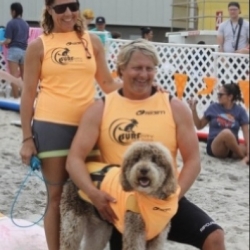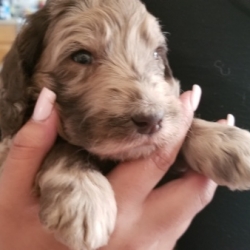


Once upon a time, all our dogs’ ancestors were wild animals that lived in packs. It was critically important to pack survival that they get along well with each other. Even a minor injury from an aggressive pack mates tooth could become infected and cause the disability and death of a pack member. Wild dogs depended on the abilities of the whole canine family to help with hunting and pack defense – a disabled member was a liability to all. For these survival reasons, dogs developed a highly ritualized language that enabled them to maintain pack order without bloodshed. Meaningful eye and facial expression, body posture, snapping, snarling, and even tooth contact without enough pressure to break skin all contributed to harmonious pack life.
Enter the human. Over the centuries, as we molded the canine species’, we created breeds such as Beagles, Bassets, Foxhounds, Coonhounds, Labradors, Golden Retrievers, and others – the hounds and sporting breeds that still have very strong genes for pack harmony. At the opposite extreme, we also created breeds such as the American Pit Bull Terrier, that genetically have very little tolerance for the proximity of others of their kind.
Within every litter there are dogs who are born followers and dogs who are born leaders. In other words, dogs with different dominance levels. Even the most dominant of dogs can get along with other dogs so long as the owners display strong leadership and proper dog to canine communication. If dogs are raised together and well socialized, they can be good friends. The bottom line is it’s all about the human owners. Owners need to be stronger minded than the dog, displaying enough authority to convince the dog that the human is in charge and is setting the rules that must be followed. Dogs that are secure with the amount of leadership the human’s project will not fight with other dogs, so long as the humans are able to properly communicate their wishes to the dog.

The basic tenet for a successful multi-dog household is simple: The more dogs in the home, the more “in charge†the human pack member must be. The “in charge†principle or belief for pack management is closely followed by this proposition: The more dogs in the household, the more well-trained and well-behaved the canine members of the pack must be. So how does a floundering human leader restore order to the pack?
The first step is management. If you are facing pack behavior challenges, start by identifying the key areas of conflict, so you can figure out how to put a management plan in place while you work on long-term training solutions.
Manage the behavior: Use management tools such as tethers, crates, and baby gates to maintain order while you modify
your dogs’ behavior through positive training.
 Let dogs be dogs: While it is not appropriate to let dogs “work it out†if conflicts are escalating and possibly dangerous, it is effective to let pack members settle small scuffles themselves. These are part of the inherited behavior developed for group survival, and can help to resolve hierarchy unrest and restore pack equilibrium.
Cultivate individual relationships: Spend quality time with each dog outside the presence of the others. This is necessary for training purposes anyway, and will help you develop a relationship with each dog as an individual. This will make it easier for you to establish your position as benevolent leader and manage the pack as a whole.
Pack Structure is not up to us..
We do not get to decide the pack order of our dogs. Humans might think that “Toby” deserves to be the pack leader but that does not mean the other dogs agree. It is not up to us to decide. Make sure you are not trying to force pack order based on who you think is the most deserving one. You can not force another dog to submit to the dog of your choice. It might be that the puppy you brought home to be Toby’s friend is naturally more dominant then Toby and you are going to have to live with the fact that the younger dog is going to be above your beloved dog in the pack order. They will be the ones to figure this out not you. Just make sure it’s done in a safe way and that they both see you as the all loving leader above both of them.
Here are some suggestions for pack management with dogs who might fight:
It’s far better to AVOID fights then to try to break one up.
There are some dogs that will never fight, but many perfectly good dogs will.

These are tips for people who are having problems within their pack. If you’re not then no need to worry… you’re already doing something that works.
1.) IF you are having pack order issues… then try serving all meals in the dogs’ crates, behind baby gates, or in separate, closed-door rooms. This can prevent fights over food and also stops the ‘piggy’ dog from chowing down all the goodies out of the ‘skinny’ or shy dog’s bowl. Nobody should be put in a position of defending their food. Mealtimes should be peaceful.
2.) Forget such treats as pigs’ ears altogether; they’re almost a guaranteed fight. Any treat that is considered so special that it might cause a fight should only be served in closed-door crates or rooms, and confiscated by you when the dog is released from confinement. If there’s only a MILD chance of a fight over something like a rawhide or chew hoof, if you have 6 dogs, throw _at least_ 12 hooves or rawhides down. Go back five minutes later and re-divide the piles. By that time, the alpha dogs will have hoarded the lion’s share. Recheck at periodic intervals, and stay close by. One of anything like a Buster Cube is circumspect as a fight-starter unless you have very mellow dogs.
3.) Never serve special treats unless you’re right there to supervise all interaction. Never throw down new chew toys and then leave for work, leaving your dogs loose.
4.) Keep an eye on your dogs. Be aware of any strutting, stiff body postures, trying to get ‘taller’ over another dog, staring, putting their head over the back of the other dog, standing with their front feet on the back of the other dog or anything that could look like one dog is challenging another. If you see it, stomp your foot on the floor (noise interruption) and say (in your firm voice), “KNOCK IT OFF!”. When this breaks up the behavior, immediately praise and love up everybody. Remove any object such as a food dish or toy that is causing the problem.
5.) Never, never, never champion and defend a beta dog because it’s depressed by it’s pack position or because you feel sorry for it!!! Do NOT mess with whatever the dogs think their pecking order might be. To do so is to invite bloody fighting and to make the beta dog think ‘god/goddess’ is on her side. After a few days of you defending her/him, your beta dog may turn into ‘the hound from hell’. Same goes for overdoing the attention to your alpha dog. Make sure if you are petting one of the other dogs and she/he comes up to you and tries to divert your attention away from the dog that you’re loving by nudging your hand or putting herself between you and the other dog .. that you push her away and tell her “WAIT”. Giving her attention now only empowers her. You need to make sure she understands you decide who and when not her. Make sure to give her attention when you are done and to keep your affection equal among the ranks.
6.) If a beta who is challenging an alpha dog for pack position keeps climbing into an alpha dog’s crate and sleeping there, keep the crate door closed at night to prevent this. This is a classic challenge for pack position.
7.) Dogs are very competitive in a pack. This means they may have contests to see who can play harder, run faster, corner tighter, and other such games. As long as this remains friendly, it’s OK. But keep in mind the whole picture of your dogs’ lives together when you’re evaluating the situation.
8.) Another time dogs are likely to fight is at the fence line when there’s a distraction such as another dog on the other side of the fence, or even over who’s first to answer the front door when guests arrive. You might think about this before you leave the house and leave dogs who have fought before loose in these areas.
9)Â Use your better judgement. Don’t let a Rottweiler freely go at a Yorkie or a 2 year old pick on a 15 year old.
10.) Make sure everybody gets their fair share of meals, treats, toys, petting, play, training and attention so there’s no need to fight for these things.
11.) There are no absolutes. Every time pack management questions arise, several people will suggest that you allow the dogs to work things out alone. They’ll assure you that this is the only way to go. Sometimes this can work, but this is dependent on the breed, individual temperaments and respective sizes of the dogs involved.
  Â
 